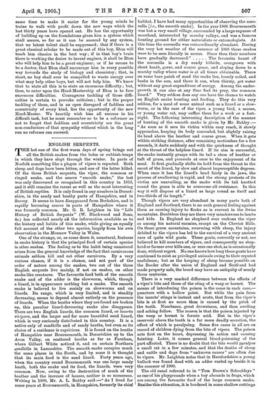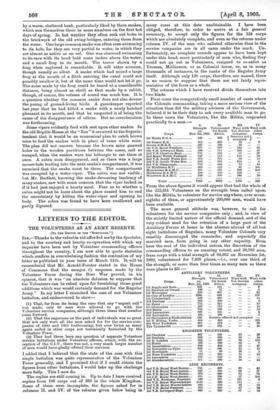all the British snakes from the holes or rubbish-heaps in
which they have slept through the winter. In parts of Norfolk something like a plague of vipers is reported. Both sheep and dogs have been bitten, and one of the latter killed. Of the three British serpents, the viper, the common or ringed snake, and the scarce "smooth snake," the last was only discovered or recognised in this country in 1853, and it still remains the rarest as well as the most interesting of British reptiles. It is only found in any numbers in Dorset- shire, in the sandy and heathy parts of Hampshire, and in Surrey. It seems to have disappeared from Berkshire, and is rapidly becoming scarce in parts of Hampshire where it was formerly common. Mr. G-. R. Leighton in his "Life History of British Serpents" (W. Blackwood and Sons, 4s.) has collected nearly all the information available as to the history and habits of this snake, while giving an equally full account of the other two species, largely from his own observation in the Monnow Valley in Wales.
One of the strange, or, as some deem it, unnatural, features in snake history is that the principal food of certain species is other snakes. The feeling as to the habit being unnatural arises from the general knowledge of the fact that carnivorous animals seldom kill and eat other carnivora. By a very curious chance, if it is a chance, and not part of the order of nature among the snakes, two out of the three English serpents live mainly, if not on snakes, on other snake-like creatures. The favourite food both of the smooth snake and of the adder is the slowworm, which, though a lizard, is in appearance nothing but a snake. The smooth snake is believed to live mainly on slowworms and on lizards. Its range, which is very limited, and is steadily decreasing, seems to depend almost entirely on the presence of lizards. When the heaths where they are found are broken up, this peculiar lizard-devouring snake also disappears. There are two English lizards, the common lizard, or lacerta irivipara, and the larger and far more beautiful sand lizard, which is very curiously distributed in this country. It is a native only of sandhills and of sandy heaths, but even so its choice of a residence is capricious. It is found on the heaths of Hampshire near Bournemouth, in Dorsetshire up to the Avon Valley, on scattered heaths as far as Farnham, where Gilbert White noticed it, and on certain Northern sandhills in Lancashire. The smooth snake occupies much the same places in the South, and by some it is thought that its main food is the sand lizard. Forty years ago, when the country round Bournemouth was one large sandy heath, both the snake and its food, the lizards, were very common. Now, owing to the destruction of much of the heather and the increase of houses, neither is so numerous. Writing in 1880, Mr. A. L. Baldry said:—" As I lived for some years at Bournemouth, in Hampshire, formerly its chief habitat, I have had many opportunities of observing the core- nella [i.e., the smooth snake]. In the year 1868 Bournemouth was but a very small village, surrounded by a large expanse of moorland, intersected by marshy valleys, and was a famous hunting ground for either naturalists or entomologists. At this time the coronella was extraordinarily abundant. During the very hot weather of the summer of 1868 these snakes were to be seen literally in scores. Since then their numbers have gradually decreased." The favourite haunt of the coronella is a dry sandy hillside, overgrown with short heath, gorse, and coarse grass, and sloping down to a marshy valley where water is at all times obtainable. There on some bare patch of sand the snake lies, loosely coiled, and basks in the sun, and there it can, when thirsty, get water without any great expenditure of energy. Among the under- growth it can also at any time find its prey, the common lizard." Very seldom does any one have the chance to watch an English snake hunting and feeding. They do this very seldom, for a meal of some animal such as a lizard or a slow- worm, or in the case of the viper, a young bird, a mouse, or young water rat, may suffice them for a week or a fort- night. The following interesting description of the manner of hunting of the smooth snake is given by Mr. Baldry :— " As soon as it sees its victim within easy reach, it slowly approaches, keeping its body concealed, but slightly raising its head above the heather and coarse grass. When it gets within striking distance, after remaining motionless for a few seconds, it darts suddenly and with the quickness of thought at the throat of the helpless lizard. If its aim is successful, the snake instantly grasps with its tail a stem of heather or tuft of grass, and proceeds at once to the enjoyment of its meal. It first gradually shifts its hold from the throat to the snout of the lizard, by slow and almost imperceptible degrees. When once it has the lizard's head fairly in its jaws, the process of swallowing is rapid, and the strong protests of its victim are unavailing, as the snake with its tail knotted round the grass is able to overcome all resistance. In this way it will dispose of a lizard as large round as itself and two-thirds of its length."
Though vipers are very abundant in many parts both of England and Scotland, there is no such general feeling against them as causing injury to flocks as is current in the Swiss mountains. Doubtless they are there very mischievous to lambs and kids. In England no shepherd ever reckons the viper as among his natural enemies, except on the Cheviot Hills. On those green mountains, swarming with sheep, the injury debited to the vipers has led to the survival of a very ancient race of quite wild goats. These goats, correctly or not, are believed to kill numbers of vipers, and consequently no shep- herd or farmer ever kills one, or sees one shot, as is occasionally done, without regret. No one knows how long these goats have continued to exist as privileged animals owing to their reputed usefulness; but as the keeping of sheep became possible on the Border after the union of England and Scotland had made property safe, the breed may have an antiquity of nearly three centuries.
There is a very marked difference between the effects of a viper's bite and those of the sting of a wasp or hornet. The means of introducing the poison is the same in each case,— puncture with a hollow point. But while the pain from the insects' stings is instant and acute, that from the viper's bite is at first no more than is caused by the prick of the tooth. Numbness, great drowsiness, and then swelling and aching follow. The reason is that the poison injected by the wasp or hornet is formic acid. But in the viper's reservoir above the tooth is a far more deadly secretion, the effect of which is paralysing. Some five cases in all are on record of children dying from the bite of vipers. The poison acts first on the heart, depressing its action and causing fainting. Later, it causes general blood-poisoning of the part affected. There is no doubt that the bite would paralyse a small rat in a few minutes, and that the deaths of sheep and cattle and dogs from "unknown causes" are often due to vipers. Mr. Leighton notes that in Herefordshire a young bullock was found dead with an adder curled up beside it in the summer of 1900.
The old canal referred to in "Tom Brown's Schooldays" as one of his playgrounds when a boy abounds in frogs, which are among the favourite food of the large common snake. Besides this attraction, it is bordered in some shallow cuttings
by. a warm, sheltered bank, particularly liked by these snakes, which sun themselves there in some numbers on,the first h,ot days of spring. In hot weather they often seek out holes in the brickwork of the old awing-bridges, entering these from the water. One large common snake was often seen swimming to its bole, for they are very partial to water, in which they are almost as active as an eel. One was observed swimming to its cave with its head held some inches above the water, and a small frog in its mouth. The terror shown by a frog when captured is remarkable. It will utter screams, though usually so silent. A snake which had seized a large frog at the mouth of a ditch entering the canal could not possibly swallow it, but at the same time would not let it go. The noise made by the frog could be beard at a considerable distance, being almost as shrill as that made by a rabbit, though, of course, the volume of sound was much less. It is a question whether the common snake does not also devour the young of ground-living birds. A gamekeeper reported last year that he bad killed, a snake with a newly hatched pheasant in its mouth, and that he suspected it of being the cause, of the disappearance of others. But no corroboration was forthcoming.
Some vipers evidently feed with zest upon other snakes. In the old Reptile House at the " Zoo " it occurred to the Superin- tendent that it would be an economical plan to catch brown mice to feed the snakes with in place of tame white mice. The plan did not answer, because the brown mice gnawed holes in the wooden partitions between the cases, and so escaped, when the snakes were too lethargic to eat them at once. A cobra soon disappeared, and as there was a large mouse-hole leading into the next snake's compartment, it was surmised that the snake must be there. The compartment was occupied. by a water-viper. • The cobra was not visible ; but Mr. Bartlett, knowing the snake-devouring tendency of many snakes, saw with some concern that the viper looked as if it had just enjoyed a hearty meal. Fear as to whether a cobra might not be loose about the place caused him to end the uncertainty by killing the water-viper and opening its body. The cobra was found to have been swallowed and partly digested.











































 Previous page
Previous page